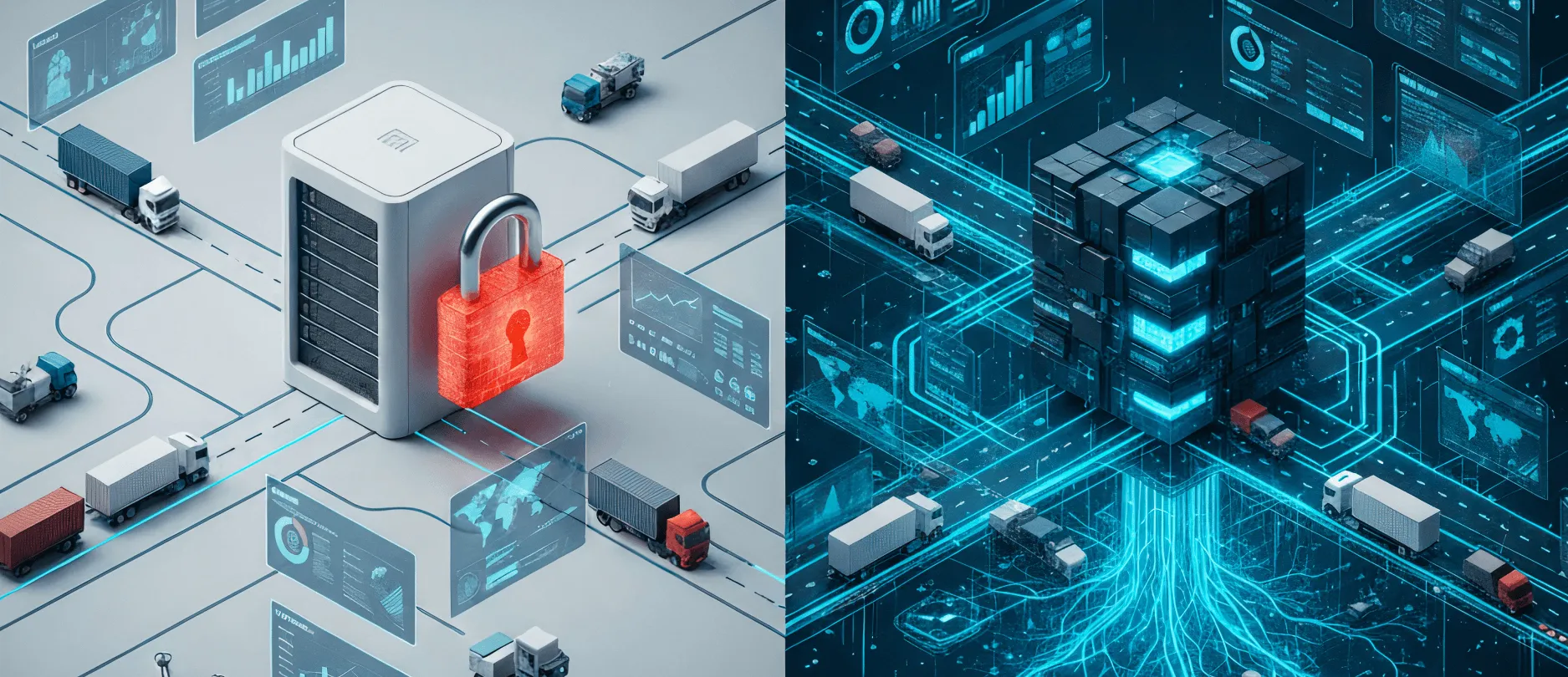
The logistics industry is under unprecedented pressure — from border delays and driver shortages to manual errors and warehouse safety risks. Using AI in logistics is rapidly becoming the key capability that allows companies to stay ahead instead of constantly reacting.
TL;DR
- Logistics faces major challenges: border congestion, driver shortages, manual workflows, and safety risks.
- AI is already solving these problems by predicting delays, automating documents, improving communication, optimizing fleets, and enhancing warehouse safety.
- This article explores seven real-world AI use cases that are already transforming logistics today, helping transportation companies build more resilient, efficient, and future-ready operations.
1. When Borders Freeze, AI Becomes the Only Early-Warning System You Can Trust
The long lines of trucks at Krakovets and Shehyni became a symbol of how unpredictable cross-border logistics has become — drivers sleeping in cabs for days, supply chains grinding to a halt.
What the headlines didn’t show was the ripple effect. Ukraine’s Kromberg & Schubert plant, a key supplier to European automakers, suddenly found its operations at risk because shipments couldn’t cross the border on time.
And here’s the real problem: the system wasn’t warning anyone early enough.
Yet companies like Maersk already run AI agents that continuously pull real-time data from ports, terminals, weather sources, and vessel traffic. When they detect a bottleneck forming — congestion, a shutdown, a lane closure — they immediately notify customers and propose alternative routes.
Early warning means alternative routing and protected deadlines. This is the kind of resilience the industry desperately needs.
Build logistics systems that don’t break under pressure
Describe your current bottlenecks — we’ll show how AI can help.
Alina
Client Manager

2. Forecasting Port Delays Before They Turn Into Costly Cascades
This summer, ships waited up to three days circling outside Rotterdam, Hamburg, and Antwerp. Fuel continued burning, storage fees piled up, penalty clauses kicked in — and operators could only react once delays had already started.
AI changes the timeline.
By combining AIS vessel data, GPS movement, IoT sensors, TMS/WMS/ERP feeds, congestion APIs, and weather patterns, AI agents can flag disruptions hours before they become visible on dashboards:
- “If this vessel doesn’t depart in six hours, expect a three-day delay chain.”
- “A reroute through Hamburg cuts 18 hours based on current queue length.”
Platforms like myDHLi already leverage this to keep customers ahead of disruptions, not behind them.
3. The Real Cost of Manual Errors That Transportation Companies Never Talk About
Paperwork is the quiet killer of logistics.
Take Macy’s: one employee managed to conceal $151 million in delivery-related costs simply because the invoice review process relied on manual checks.
Now compare that with C.H. Robinson. They automated freight class validation with AI:
- tenders scanned instantly,
- errors corrected automatically,
- orders pushed straight into processing.
The result? Over 75% of their LTL shipments move without human involvement.
AI doesn’t replace people — it removes the failure points that humans shouldn’t be responsible for in the first place.
4. The Hidden Reason Customers Get Angry — Even When Deliveries Are On Time
A logistics partner once told me they had three full-time employees answering nothing but:
- “Where is my shipment?”
- “Can I change the address?”
- “When will it arrive?”
And yet they were a highly reliable carrier.
The problem wasn’t performance. It was communication.
AI is finally bridging this gap.
Today, AI agents can automate shipment updates, ETA notifications, appointment booking, common FAQ responses, even preliminary rate discussions. Solutions like HappyRobot are already reducing support workloads while dramatically improving customer experience.
Because no matter how good your operations are — if customers feel uninformed, they won’t remember the on-time delivery.
5. When Every Fourth Truck Stands Idle, AI Becomes a Workforce Multiplier
Ukraine’s logistics industry is facing a severe driver shortage. Officially, one in four trucks has no driver available. In many private companies, the shortage is closer to 50%.
Training new drivers — men or women — takes months. But the cargo needs to move today.
AI helps logistics companies stretch available workforce capacity by:
- predicting driver fatigue,
- optimizing shift schedules,
- redistributing loads automatically,
- matching drivers to shipments in real time (as Uber Freight does).
AI can’t create new drivers — but it can ensure every available driver operates smarter, not harder.
6. When Warehouse Safety Meets Robotics: Drones Do What Humans Shouldn’t
Warehouse workers are twice as likely to be injured as the average industrial worker — especially when checking high racks.
CEVA Logistics in Chile decided to remove this risk entirely.
They deployed drones that fly through aisles autonomously while AI reads labels, counts stock, flags discrepancies, and directs workers only to areas requiring attention.
The outcome is dramatic:
- inventory checks 10× faster,
- fewer injuries,
- higher accuracy,
- lower maintenance costs than scissor lifts.
Sometimes automation isn’t about efficiency. Sometimes it’s about safety — and humanity.
7. From Reaction to Prediction: How AI Turns Logistics Into a Forward-Looking Operation
This is the biggest, most transformational change AI brings to logistics.
Traditionally, logistics runs on post-factum reporting. Dashboards tell you what went wrong after it went wrong.
AI flips the model.
AI predicts:
- upcoming disruptions,
- emerging bottlenecks,
- unrealistic ETAs,
- overworked drivers,
- unsafe warehouse conditions,
- inefficient routes,
- missing documents,
- rising operational risks.
And it recommends actions before problems escalate.
This is what modern logistics resilience looks like: less firefighting, more foresight.
AI Is Ready for Logistics — But Most Companies Aren’t Ready for AI
Over the past 16+ years of working with logistics and transportation companies, we’ve seen one pattern repeat itself again and again. AI can already optimize routes, plan loads, support dispatchers, automate communication, and improve warehouse operations — but many organizations are still relying on spreadsheets and manual processes long after better alternatives exist.
The issue is rarely about whether the technology is “ready.” Today, AI agents can simulate thousands of delivery scenarios in seconds, recommend faster and cheaper routes based on real-time conditions, predict equipment failures before they affect operations, and even support warehouse teams with drone-powered inventory management.
What slows companies down is not the technology — it’s adoption. Pilot projects get stuck at the proof-of-concept stage, implementation is postponed to “next quarter,” and operational teams remain overloaded while AI solutions sit unused.
From our experience building solutions for transportation companies, the true challenge for the industry is developing the readiness, processes, and mindset needed to let AI do the work it’s already capable of doing today.
If you're ready to make AI actually work in your logistics operations, we're here to help.
Final Words: Why AI Is No Longer Optional for Building a Resilient Logistics Operation
AI won’t stop border protests, calm political tensions, or magically add thousands of new drivers to the market. But it can reduce the operational damage these crises cause — and help companies maintain stability in an unstable world.
The logistics companies that adopt AI today won’t just keep up. They’ll lead.
With over 16 years of experience building custom logistics software, Stfalcon helps companies integrate AI into real operations — predictive monitoring, warehouse automation, driver optimization, communication AI and more.
If you want to strengthen your logistics operations with AI, reach out and let’s build it together.



